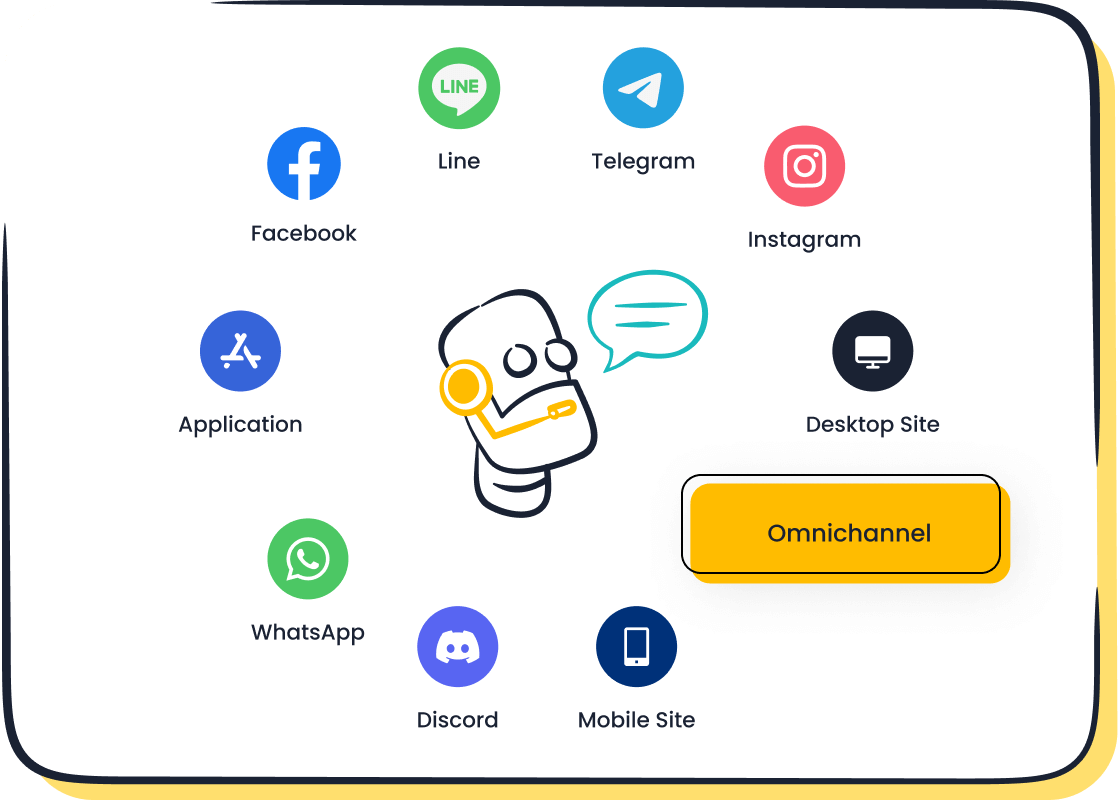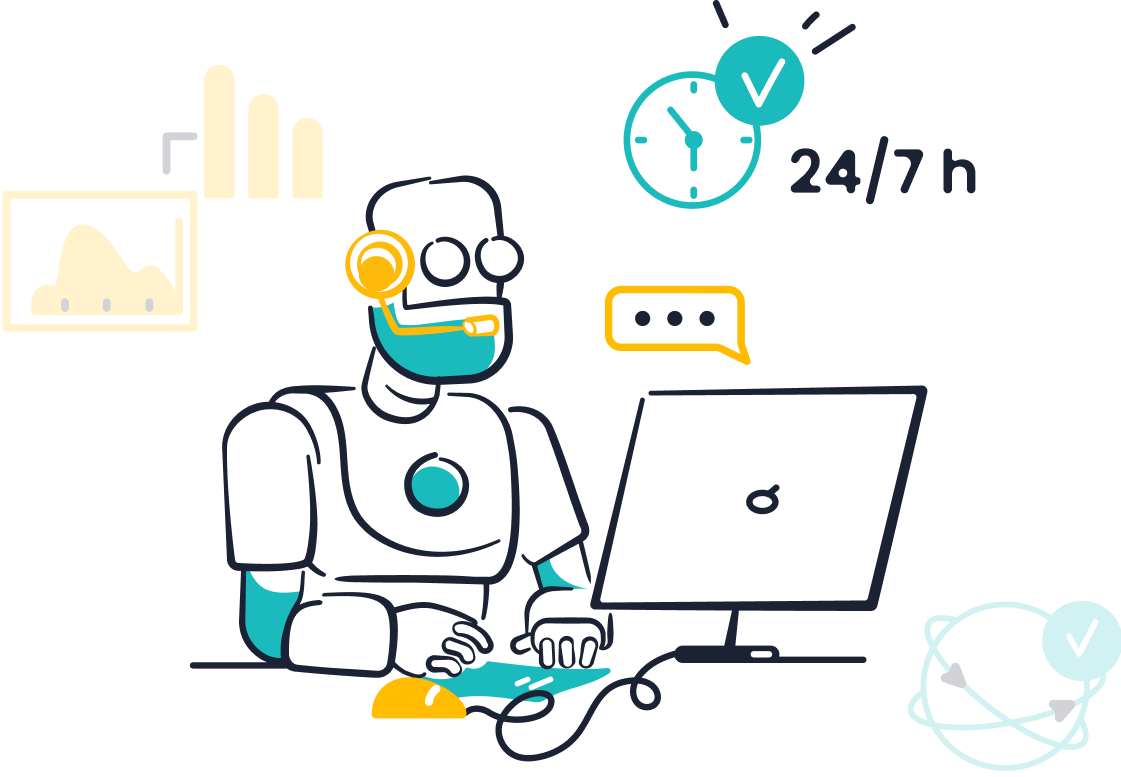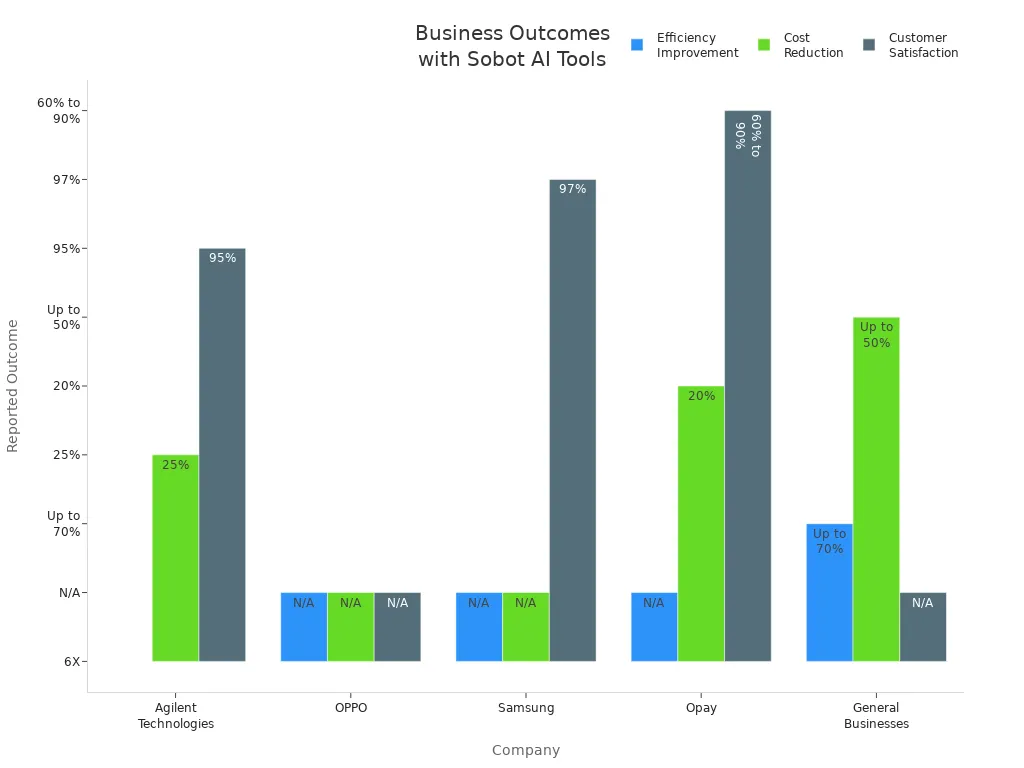Customer Success AI Tools Implementation Made Simple

You can easily implement customer success ai tools and see real improvements in customer satisfaction. Companies using ai-powered customer success solutions report a 15% increase in satisfaction and 12% growth in revenue. Sobot offers solutions like Sobot AI and the Sobot call center, which simplify support and boost engagement. Adoption rates are rising, with 63% of marketers already using AI. Follow a simple process and unlock better results for your business.
| Metric | AI-Powered Customer Success Solutions | Traditional Customer Support Methods |
|---|---|---|
| Marketers currently using AI | 63% | N/A |
| Trial-to-paid conversion rate | 56% | 32% |
| Sales cycle length | 20 weeks | 25 weeks |
Why Use Customer Success AI Tools

AI Benefits
You can transform your business by using ai in customer success operations. Artificial intelligence in customer success brings many advantages that manual processes cannot match. With ai technologies, you can engage with customers in real time and at scale. This means you respond faster and more personally, which improves satisfaction. Automation of routine tasks increases efficiency and lets your team focus on complex issues. Ai analyzes large amounts of customer data, giving you insights that help you make better decisions.
- Ai enables real-time, personalized engagement for every customer.
- Automation frees your team from repetitive tasks, boosting productivity by up to 40%.
- Ai technologies use predictive analytics for churn prediction, helping you keep more customers.
- Ai in customer success operations extracts insights from unstructured data, like chat logs and social media.
- Ai adapts to changing customer behaviors, learning and improving over time.
Early adopters of artificial intelligence in customer success report 20-40% reductions in operational costs. Ai chatbots, like those from Sobot, can reduce service costs by up to 40%. Sobot’s ai-powered chatbot operates 24/7, handling thousands of queries at once and providing consistent, expert-level support. This allows you to scale your support without hiring more staff.
Tip: Ai-driven automation can deliver meaningful improvements in just a few weeks, making it a fast and effective solution for your business.
Customer Experience Impact
Ai technologies have a big impact on customer experience. You can offer instant replies, with ai reducing response times by up to 50%. Ai-powered systems, such as Sobot’s chatbot, provide 24/7 support, so your customers never have to wait for help. Ai in customer success operations manages more inquiries per hour than traditional teams, ensuring no one gets left behind.
- Ai enables proactive support by detecting issues before they become problems, reducing churn.
- Ai personalizes every interaction by analyzing customer history and preferences.
- Automation lets your agents focus on complex needs, improving service quality.
- Ai-driven knowledge management updates information dynamically, so customers always get accurate answers.
A recent study found that 72% of consumers prefer companies that offer faster service with ai. Businesses using artificial intelligence in customer success see up to 40% lower costs and higher satisfaction scores. Ai technologies also help you build long-term loyalty by delivering personalized experiences and proactive engagement. Sobot’s ai solutions integrate with your existing systems, giving you a unified view of each customer and supporting your growth.
Setting Goals for AI Implementation
Define Success
You need clear goals before starting any ai implementation. Setting these goals helps you measure progress and see real results. Begin by asking what you want to achieve with ai. Do you want faster response times, higher customer satisfaction, or more sales? You should pick goals that match your business needs.
Marc Beierschoder from Deloitte Switzerland says you must honestly assess your business aims. This helps ai tools solve your biggest problems and give you a competitive edge. You should also check if your ai solution fits with your current systems and meets security rules like GDPR.
Use key performance indicators (KPIs) to track success. The table below shows common KPIs for ai implementation:
| KPI Category | Key Performance Indicators (KPIs) | Description |
|---|---|---|
| Operational Efficiency | Process Times, Error Rates, Automation | Measures speed, accuracy, and how much ai reduces manual work. |
| Customer Satisfaction | Response Times, Service Quality, Retention | Tracks how fast you help customers, service quality, and loyalty. |
| Revenue Growth | New Leads, Upsell Rates, Sales Contribution | Shows how ai helps you find leads, upsell, and boost sales. |
You should monitor these KPIs during your ai transformation. Sobot’s ai-powered chatbot, for example, can improve response times and automate routine tasks, helping you reach your goals faster. You can learn more about Sobot’s chatbot features here.
Tip: Start with small ai projects, like chatbots for common questions, then scale up as you see results.
Identify Use Cases
You should choose use cases that bring the most value to your business. Ai implementation works best when you focus on tasks that need automation or data-driven insights. Common use cases include:
- Personalizing customer journeys by using ai with CRM tools to learn about customer interests.
- Spotting single-threaded accounts and mapping contacts for better engagement.
- Predicting churn and tracking customer trends for strategic interventions.
- Automating support tasks, such as handling routine queries, creating tickets, and enabling self-service with ai chatbots.
Sobot’s ai solutions help you automate support, personalize interactions, and manage tickets across channels. You can use ai to handle thousands of queries at once, freeing your team for complex issues. This approach follows best practices for implementing ai and ensures your implementation delivers real business impact.
Note: Always align your ai implementation with your business priorities and monitor results to keep improving.
Choosing the Right AI Tools
Sobot Chatbot Overview

When you look for customer success ai tools, you want a solution that brings real value to your business. Sobot stands out as a leader in this space. The Sobot Chatbot gives you an all-in-one platform that connects every customer channel and communication method. You do not need to switch between different systems. Sobot launched its Five-AI system in 2024, which includes Omnichannel AI, Scenario-based AI for retail and e-commerce, Multi-faceted AI agents, Generative AI powered by top language models, and Secure AI for data privacy.
Here are some features that make Sobot’s ai solutions unique:
- All-in-one customer contact platform for seamless communication.
- Omnichannel support, so you can reach customers on chat, email, voice, and social media.
- Over 300 statistical reports with thousands of indicators to track performance.
- Fast resolution times, often under one minute.
- Competitive pricing with no hidden fees.
- Integration with platforms like Amazon, Shopify, and Salesforce.
- Customizable AI agents and copilots to fit your business needs.
- Secure data handling and compliance with privacy standards.
Sobot’s ai customer service helps you improve conversion rates by 15%, reduce agent workload by 60%, and boost customer satisfaction scores by 35%. You get timely support from Sobot’s team, including sales and customer success managers, making your experience smooth and reliable.
Tool Selection Tips
Choosing the right customer success ai tools means you need to match your business needs with the right features. Start by identifying the problems you want to solve with ai. Set clear goals, such as improving efficiency or raising customer satisfaction. Research ai solutions that fit your needs, looking at how they scale and integrate with your current systems.
Here are steps to help you compare and select ai tools:
- Define your business needs and set measurable goals.
- Check if the ai solutions offer scalability and easy integration with your CRM or marketing platforms.
- Evaluate user-friendliness and customization options.
- Look for strong customer support and training resources.
- Review security and privacy compliance, especially for sensitive data.
- Compare costs and expected return on investment.
- Read user reviews and case studies to see real-world results.
- Test the tool with a pilot project before full deployment.
A good ai tool should unify customer data from all channels, provide real-time support, and personalize every interaction. Sobot’s ai technologies do this by using advanced analytics and natural language processing. You can monitor usage metrics, manage subscriptions, and engage customers proactively. This approach leads to better customer experiences and higher retention rates.
Tip: Always involve your team in the selection process and provide training on new ai solutions. This helps everyone adapt and get the most value from your investment.
| Criteria | Why It Matters |
|---|---|
| Omnichannel Support | Ensures seamless customer experience |
| Integration | Connects with your existing systems |
| Customization | Adapts to your unique business needs |
| Security & Compliance | Protects customer data and meets regulations |
| Analytics & Reporting | Tracks performance and identifies improvements |
By following these steps, you can choose customer success ai tools that drive real results. Sobot’s ai solutions offer a complete, easy-to-use platform that grows with your business.
Preparing Data and Systems
Data Quality
You need high-quality data for customer success AI tools to work well. Good data helps AI systems give accurate answers and make smart decisions. If your data has errors or missing parts, your AI tools may not perform as expected. You should focus on making your data accurate, complete, and consistent.
A strong data governance framework sets clear rules for how you collect, store, and use data. This framework helps your team stay accountable and keeps your data safe. You can use automated tools to check for errors, duplicates, or missing information. Regular data cleaning and profiling help you find and fix problems quickly.
| Data Quality Standard | Description | Purpose |
|---|---|---|
| Data Governance Framework | Set roles and rules for managing data | Ensures accountability and consistency |
| Continuous Monitoring | Use automated checks for accuracy and completeness | Keeps data reliable and up-to-date |
| Data Profiling and Cleansing | Find and fix errors, duplicates, and inconsistencies | Maintains accuracy and trust in your data |
| Standardized Data Entry Processes | Use templates and validation rules for entering data | Reduces mistakes and improves uniformity |
| Building Data Literacy Across Teams | Train staff on data quality and best practices | Fosters a culture of responsibility and improvement |
| Traceability (Lineage) | Track where data comes from and how it changes | Builds confidence in data reliability |
You should train your team on data management. When everyone understands why data quality matters, your AI tools will work better. Sobot’s platform supports data integration from many sources, helping you create a single, unified view of each customer. This unified approach lets you personalize support and make better business decisions.
Tip: Clean, well-organized data leads to more accurate AI insights and better customer experiences.
Integration Steps
You can follow clear steps to connect AI tools like Sobot with your current business systems. Start by setting goals for your AI project. Decide what you want to achieve, such as faster response times or better customer satisfaction. Next, look at your data sources. Make sure your data is ready, clean, and easy to access.
Here are the main steps for successful AI integration:
- Define your business goals and choose a high-impact use case.
- Prepare your data by cleaning and organizing it for the AI tool.
- Select the right AI solution, such as Sobot’s chatbot, that fits your needs.
- Test the AI tool with a small pilot project to see how it works.
- Train your team on how to use the new system and assign clear roles.
- Roll out the AI tool step by step, using feedback to improve as you go.
- Monitor the AI’s performance and make changes based on real results.
You should also make sure your systems can handle the new AI tools. Sometimes you need to update your software or hardware. Work with your IT team to keep everything secure and running smoothly. Sobot’s solutions offer easy integration with popular platforms, so you can connect chat, email, and voice channels without hassle.
Note: Continuous monitoring and regular updates help your AI tools stay effective and secure.
A unified data approach, like the one Sobot provides, helps you deliver personalized support and make smarter decisions. When you follow these steps, you set your business up for long-term success with AI.
Team Training and Adoption

Building Skills
You need to prepare your team for successful ai adoption. Training starts with the basics. Begin by explaining what AI is and how it helps your business. Use real examples that match each team member’s daily tasks. This approach makes learning relevant and reduces anxiety.
A strong training program includes several steps:
- Start with simple AI concepts and show how they apply to your team’s roles.
- Share easy-to-follow guides, FAQs, and video tutorials. These resources let your team learn at their own pace.
- Schedule regular follow-up sessions and refresher courses. Keep support channels open, such as Slack or a helpdesk, so your team can ask questions anytime.
- Encourage peer learning. Set up “AI office hours” or mentorship programs where team members help each other.
- Integrate training into tools your team already uses, like CRMs or chat platforms. This keeps learning smooth and avoids disruption.
- Use AI-powered onboarding programs. These can create custom learning paths for each role and track progress with analytics.
Sobot offers user-friendly documentation and ongoing support, making it easier for your team to build skills quickly. You can embed Sobot’s training modules into your existing workflows, which helps your customer success manager and team stay engaged and confident.
Tip: Ongoing learning and peer support help your team master new tools and keep up with best practices for implementing ai.
Overcoming Resistance
You may face resistance when introducing new AI tools. Some team members might worry about job changes or feel unsure about new technology. Clear communication and strong leadership help address these concerns.
Common challenges during ai adoption include unclear goals, fear of job loss, and worries about data security. You can overcome these by:
- Explaining the benefits of AI and how it supports your team’s work.
- Sharing positive stories and case studies to build trust.
- Involving employees early by choosing champions and pilot teams.
- Rolling out AI tools gradually, starting with pilot projects to show quick wins.
- Keeping communication open and transparent. Let your team ask questions and share feedback.
A hybrid approach works well. Let AI handle routine tasks, while your team focuses on complex customer needs. This balance keeps customer empathy strong and shows the value of human skills.
Sobot’s solutions support a smooth transition by offering easy integration and continuous support. You can track progress with analytics dashboards and adjust training as needed. This approach helps your team see the value of ai adoption and builds momentum for wider use.
Note: Addressing concerns early and showing real results encourages your team to embrace ai adoption and drive business success.
AI Implementation Steps
Deployment Process
You can make ai implementation simple by following a clear step-by-step process. Sobot’s platform helps you move from planning to full deployment with ease. Here is how you can deploy customer success ai tools like Sobot:
-
Identify Use Cases
Start by choosing the main problems you want to solve with ai. For example, you might want to automate common customer questions or improve response times. Sobot’s scenario-based ai design lets you pick industry-specific flows, so you do not need a complex setup. -
Balance Automation and Human Touch
Use ai to handle routine tasks, but keep humans in the loop for complex or sensitive issues. Sobot’s tools let you set rules for when to transfer chats from ai to a live agent. This balance keeps your customers happy and builds trust. -
Train Your Team
Teach your team how to use the new ai tools. Sobot offers easy-to-follow guides and support. Training helps your staff feel confident and ready for the change. -
Integrate with Your Systems
Connect Sobot with your existing platforms, such as e-commerce, CRM, or helpdesk software. Sobot’s plug-and-play modular design makes integration fast and reduces development time. You can unify all customer touchpoints for a seamless experience. -
Test and Optimize
Run a pilot project to see how the ai works in real situations. Use real-time data and intelligent troubleshooting flows to spot any issues. Make changes based on feedback from both customers and agents. -
Personalize Messaging
Set up multi-channel messaging so your customers get the same high-quality support on chat, email, voice, and social media. Sobot’s ai can deliver human-like responses across all channels. -
Go Live and Support
Launch your ai solution to all users. Sobot provides ongoing support, so you can get help whenever you need it. You can also access a library of resources and best practices.
Tip: Sobot’s modular design and scenario-based flows help you deploy ai faster and with less risk. You can start small and scale up as you see results.
Here is a quick checklist for your ai implementation:
- [ ] Define your main use cases
- [ ] Train your team
- [ ] Integrate with current systems
- [ ] Test with a pilot group
- [ ] Personalize customer messaging
- [ ] Launch and monitor
By following these steps, you can make ai implementation smooth and effective. Sobot’s support team stands ready to help you at every stage.
Monitoring and Optimization
After deployment, you need to focus on monitoring and optimization. This ensures your ai tools keep working well and deliver value over time. Sobot gives you the tools to track performance and make improvements.
Key Metrics to Monitor
You should track several types of metrics to measure the success of your ai implementation. Here is a table with important categories and examples:
| Metric Category | Key Metrics Examples |
|---|---|
| AI-specific performance | Resolution Rate (calls fully handled by ai), Intent Accuracy, Transfer Rate (calls sent to humans) |
| Operational impact | Cost Per Resolution, First-Call Resolution Rate, Capacity Planning Efficiency |
| Business impact | Customer Satisfaction (CSAT), Net Promoter Score (NPS), Agent Attrition Rate, Return on Investment |
You can use Sobot’s analytics dashboard to view these metrics in real time. This helps you spot trends and make quick decisions.
Steps for Effective Monitoring and Optimization
-
Define KPIs
Set clear goals for your ai implementation. Choose KPIs like response times, customer satisfaction scores, and quality of interactions. -
Track and Analyze Data
Use Sobot’s reporting tools to monitor operational efficiency, customer satisfaction, and ai-specific performance. Look for patterns in call handling times, pick up rates, and resolution rates. -
Continuous Monitoring
Check your ai tools regularly. Watch for drops in performance or changes in customer sentiment. Sobot’s system alerts you to issues so you can act fast. -
Collect Feedback
Ask both customers and agents for feedback. Use this input to improve ai training and make the system more adaptable. -
Update and Retrain
Regularly update your ai models. Add new data and fine-tune algorithms to keep up with changing needs. Sobot makes it easy to retrain your ai without starting from scratch. -
Maintain Security and Compliance
Protect customer data with strong encryption and regular security audits. Sobot follows strict privacy standards to keep your information safe.
Note: Monitoring performance is not a one-time task. You need to keep checking and improving your ai tools to get the best results.
Long-Term Maintenance
For long-term success, you must keep your ai implementation aligned with your business goals. Here are some best practices:
- Monitor key metrics like response times, resolution rates, and customer satisfaction.
- Retrain your ai models when you see performance changes.
- Combine ai automation with human support for complex cases.
- Keep your team trained on new features and updates.
- Document your processes and troubleshooting steps for easy knowledge transfer.
- Plan for future growth by scaling your support infrastructure as your business expands.
Sobot’s support resources help you with ongoing maintenance. You get access to technical experts, regular updates, and a knowledge base. This support ensures your ai implementation stays effective and ready for new challenges.
Leveraging ai for transformative customer success means you never stop improving. With Sobot, you gain ai insights that help you adapt quickly and stay ahead of customer needs.
Example:
OPPO used Sobot’s ai tools to handle a surge in customer inquiries. By monitoring key metrics and retraining their ai, they achieved an 83% chatbot resolution rate and a 94% positive feedback rate. This shows how continuous monitoring and optimization can drive real business results.
Remember: ai implementation is a journey, not a one-time event. Keep learning, keep optimizing, and you will see lasting benefits.
Real-World Results
OPPO Success Story
You can see how Sobot’s AI chatbot brings real change by looking at OPPO’s experience. OPPO faced a surge in customer inquiries during busy shopping seasons. The company needed a way to answer questions quickly and keep customers happy. By using Sobot’s AI chatbot, OPPO reached an 83% resolution rate for customer issues. The chatbot handled repetitive questions, so human agents could focus on more complex problems. This shift improved customer satisfaction, with OPPO receiving a 94% positive feedback score. You can also notice a 57% increase in repurchase rates after the chatbot launch. These results show that Sobot’s solutions help businesses respond faster and build stronger customer loyalty.
Sobot’s AI chatbot helped OPPO reduce agent workload and improve service quality. Customers got answers quickly, and agents had more time for important tasks.
Measurable Outcomes
You can measure the impact of Sobot’s AI tools in many ways. Companies report faster ticket resolution and lower support costs. For example, Sobot’s AI chatbots cut customer service costs by 30%. AI automation resolves tickets 52% faster than traditional methods. Businesses also see better customer satisfaction scores. OPPO’s story is not unique. Other companies, like Agilent Technologies and Samsung, have seen big improvements.
| Company | Measurable Outcomes with Sobot AI Tools |
|---|---|
| Agilent Technologies | 6X increase in operational efficiency, 25% cost reduction, 95% satisfaction |
| OPPO | 83% chatbot resolution rate, 57% increase in repurchase rates |
| Samsung | 97% customer satisfaction rate using multilingual and real-time insights |
| Opay | Satisfaction improved from 60% to 90%, 20% cost reduction |
| General Businesses | Up to 70% productivity improvement, up to 50% reduction in service costs |

You can use Sobot’s solutions to reduce churn by anticipating customer needs and solving problems before they grow. AI-driven ticket routing and sentiment monitoring help you act fast and keep customers loyal. Proactive chatbots analyze patterns, so you can resolve issues early and prevent churn. Strategic deployment and agent training ensure you get rapid results and better teamwork.
Sobot’s solutions give you the tools to boost efficiency, lower costs, and improve customer experience. You can see real business growth when you use AI to support your team and customers.
Overcoming Challenges
Integration Issues
You may face challenges when adding ai tools to your business systems. Many companies find it hard to connect new ai solutions with their current CRM or customer success platforms. Problems often come from data that is incomplete or out of date. You can solve these issues by choosing ai tools that work well with your existing workflows. Sobot, for example, offers easy integration with popular platforms and helps you keep your data accurate.
Common integration challenges include:
- Complex connections between ai and old systems
- Data quality problems that slow down ai performance
- High costs and lack of skilled staff
You can overcome these by creating a clear plan, setting goals, and working with both ai experts and business leaders. Start with a pilot project and expand as you see results.
Tip: Use ai solutions that offer flexible integration and support, like Sobot, to reduce setup time and avoid workflow disruptions.
Data Privacy
Protecting customer data is a top priority when using ai. You must follow rules like GDPR, CCPA, and other privacy laws. Leading ai solutions use features such as data minimization, encryption, and consent tracking. Sobot’s platform supports secure data handling and meets strict privacy standards.
Key steps to ensure data privacy:
- Use ai tools with built-in privacy features, like anonymization and encryption
- Work with your legal and IT teams to monitor compliance
- Choose solutions that support user rights, such as the right to be forgotten
A privacy-first approach builds trust with your customers and keeps your business safe.
Team Buy-In
Getting your team to accept ai can be tough. Some people worry that ai will replace their jobs or make their work harder. You can address these fears by showing how ai helps, not replaces, employees. Ai takes care of repetitive tasks, so your team can focus on more important work.
Ways to encourage team buy-in:
- Explain the benefits of ai in simple terms
- Share success stories from companies like OPPO, who improved service with ai
- Offer training and support to build confidence
Note: A culture of learning and innovation helps your team see ai as a tool for growth, not a threat.
You can make customer success AI implementation simple by following a few clear steps. Start by evaluating your needs, integrating AI tools like Sobot with your current systems, and customizing features for your business. Build team skills and monitor key metrics to refine your approach. Use AI to automate routine tasks and gain insights from customer data. With the right implementation, you create stronger customer relationships and drive better results. Take the first step today and see how Sobot can help you succeed.
✅ Quick Checklist:
- Evaluate needs
- Integrate and customize
- Train your team
- Monitor and optimize
FAQ
What are customer success AI tools?
Customer success AI tools help you automate support, analyze customer data, and improve satisfaction. You can use these tools to answer questions faster and predict customer needs. Sobot’s AI chatbot, for example, handles thousands of queries every day and boosts productivity by 70%. Learn more.
How do I start using customer success AI tools?
You can begin by setting clear goals and choosing a trusted provider like Sobot. Clean your data, train your team, and run a pilot project. Sobot’s platform offers easy integration with chat, email, and voice channels, making your first steps simple and effective.
Are customer success AI tools secure?
Yes, leading customer success AI tools use strong security features. Sobot follows strict privacy standards, including GDPR compliance and data encryption. You protect customer information and build trust by using secure AI solutions. Sobot’s system stability reaches 99.99%, ensuring reliable service.
What results can I expect from customer success AI tools?
You can expect faster response times, lower costs, and higher satisfaction. OPPO saw an 83% chatbot resolution rate and a 57% increase in repurchase rates after using Sobot’s AI tools. Many businesses report up to 50% cost reduction and improved customer loyalty.
Can customer success AI tools work with my current systems?
You can integrate customer success AI tools with most business platforms. Sobot supports connections with CRM, e-commerce, and helpdesk software. You unify customer data and streamline support across all channels. This helps you deliver a seamless experience and grow your business.
See Also
Enhancing Customer Support Efficiency With AI Software Solutions
Best Ten AI Technologies For Enterprise Contact Centers
An In-Depth Look At AI Call Center Technologies
How AI Agents Are Transforming Customer Service Support
Ten Strategies To Improve Customer Satisfaction In Live Chat
